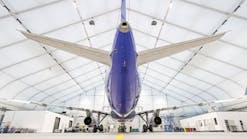The massive size of hangars and terminals can mean massive costs and issues when it comes to keeping a comfortable climate for employees and travelers. But before you look at costly HVAC system upgrades to meet these demands, you may want to consider destratification fan systems (DFS).
“This continual airflow creates a current within the air space. Once that current is established, it requires very little energy to maintain,” said Joel Sasso, president of DRD Systems, a supplier of DFS units. “This is how our system saves energy/money for our customers, while increasing the air quality and overall comfort for their customers and employees.”
Destratification means removing the separated temperature layers from the air within an enclosed space and equalizing the temperature from ceiling to floor. The traditional method of attempting to equalize temperature uses a ceiling fan or HVLS fan – both of which spin paddles/blades, creating a turbulent flow of air.
A destratification fan converts all that rotational flow/energy into Laminar flow, creating a narrow/tight column of air which flows continually. Airports with high ceilings can take stress of the HVAC system using a destratification fans. They equalize the temperature within the facility, which makes it easier to maintain a specific climate.
Gama Aviation at Farnborough Airport was experiencing high energy costs inside its main engineering hangar. The company noticed their heating units ran non-stop, even during the day and their thermostat setpoint was never met. They were looking for a way to decrease their energy costs, without sacrificing occupant comfort.
Gama installed DFS units and Sasso said the company realized an energy cost savings of 50 percent along with a sizeable reduction in natural gas usage and the company only needed one of its two heating units to maintain desired conditions.
“The only challenge to installing the DFS system was running the electrical power supply to each unit,” he said. “Not much of a challenge as it’s basic, general electrical work.”
Sasso said the company offers a PureAir option inside the fans to mitigate mold, viruses, bacteria and VOCs throughout every cubic inch of air throughout a facility. The PureAir systems use either PhotoHydroIonization (PHI) or a Needlepoint Bi-Polar Ionization (NBPI) module.
“We would strongly suggest utilizing the PureAir options in the restrooms, as they will keep the floors dry while keeping the air and surfaces sanitized, 24/7/365” Sasso said. “The PureAir option would also be helpful in reducing person-to-person virus transference in all other areas of congregation like boarding areas/gates.”
Sasso said his company offers free layout design services for any facility if provided the floor plans and dimensions. They will put together a DFS plan, which will help designers or airports understand how many units and optimal placement to build the most efficient system to address concerns.
“A DFS unit runs on very little energy and it equalizes the temperature using fluid currents rather than simply adding more power/force to the traditional method of mixing air” he said. “The patented stator is the key to our DFS units creating this laminar flow so beware of the imitators which are, simply put, a fan in a tube without the stator.”







